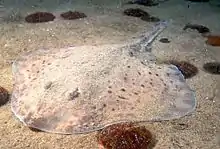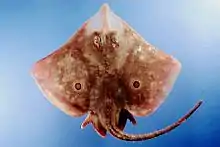Rajiformes
Rajiformes /ˈrædʒɪfɔːrmiːz/ is one of the four orders in the superorder Batoidea, flattened cartilaginous fishes related to sharks. Rajiforms are distinguished by the presence of greatly enlarged pectoral fins, which reach as far forward as the sides of the head, with a generally flattened body. The undulatory pectoral fin motion diagnostic to this taxon is known as rajiform locomotion. The eyes and spiracles are located on the upper surface of the head and the gill slits are on the underside of the body. Most species give birth to live young, although some lay eggs enclosed in a horny capsule ("mermaid's purse").
| Rajiformes | |
|---|---|
 | |
| Little skate (Leucoraja erinacea) | |
| Scientific classification | |
| Kingdom: | Animalia |
| Phylum: | Chordata |
| Class: | Chondrichthyes |
| Superorder: | Batoidea |
| Order: | Rajiformes L. S. Berg, 1940 |
| Type species | |
| Raja batis | |
Characteristics
Rajoids typically have a dorsoventrally flattened body. The snout is slender and pointed and the wide mouth, often covered with a fleshy nasal flap, is on the underside of the head. The eyes and well-developed spiracles are located on the top of the head. In most species, the spiracles are large and are the main means of drawing water in for respiration. There is no nictitating membrane and the cornea is continuous with the skin surrounding the eyes. The gill slits are on the ventral surface just behind the head and there are five in all species except the sixgill stingray (Hexatrygon bickelli).[2] The front few vertebrae are fused into a synarcual and this either articulates with the bones of the well-developed pectoral girdle or is fused to them, the suprascapulae uniting above the vertebral column.[3] Most species have enlarged, thorn-like dermal denticles on their skin, often with a row of large denticles along the spine.[2]
The pectoral fins are large, but not clearly demarcated from the body, and together with the body are known as the disc. They start from the side of the head in front of the gill openings and end at the caudal peduncle. There are up to two dorsal fins but no anal fin. A slender tail is clearly demarcated from the disc. The caudal fin varies in size between species and the rays have a whip-like tail with no caudal fin.[2]
Distribution
Species of the order Rajiformes are found throughout the world's oceans, from Arctic to Antarctic waters, and from shallow coastal shelves to open seas and abyssal regions. A few are found in rivers and some in estuaries, but most are marine, living near the sea bed at depths down to 3,000 m (9,800 ft) or more.[2]
Diversity
Families
Four extant and two extinct families of rajoid are currently recognized:[4][5]
- Anacanthobatidae
- Arhynchobatidae
- Gurgesiellidae
- Rajidae
- †Sclerorhynchidae
- †Ptychotrygonidae
- Clade containing †Ischyrhiza, †Schizorhiza, and †Onchopristis
Formerly, some Rhinopristiforms were also included.
The smooth skates, the Anacanthobatidae, contain a single genus, Anacanthobatis, of about 10 species. They are small fish living on the continental slopes of tropical and subtropical waters, and are native to Natal, South Africa, tropical West Africa, and Taiwan. Smooth skates have a filament extending from a rounded protuberance on the snout. Both the dorsal and ventral surfaces are smooth and have no dermal denticles. The tail is slender and a little shorter than the body. No dorsal fins are present and the caudal fin is small and membranous.[6]

The skate family Rajidae contains 14 genera and around 200 species. They are found worldwide, but are relatively uncommon near coral reefs and in shallow tropical seas. A few species occur in brackish water. The disc shape is rhomboidal, and the tail long. Two dorsal fins are found and the caudal fin is much reduced. The pelvic fins have two lobes. Most species have rough skins with dermal denticles which are especially obvious along the spine. The eggs are laid in a protective hard case with string-like elongations at the four corners.[7]
The extinct families Sclerorhynchidae and Ptychotrygonidae had long, serrated rostrums very similar to those of extant sawsharks and sawfishes, and their relation to them has been debated. A 2004 study found sawsharks to actually be the most basal of batoids rather than true sharks, with the order Sclerorhynchiformes containing Sclerorhynchidae and Ischyrhizidae and forming a sister group to sawfish and all other rays, with the clade containing sawsharks and rays being coined Pristiorajea.[8][9] However, further studies have affirmed that sawsharks are true sharks and a member of Selachimorpha. A 2019 study instead found Sclerorhynchiformes to be a paraphyletic assemblage of rays within Rajiformes and leading up to Rajidae, and thus downgraded Sclerorhynchidae and Ptychotrygonidae to being families within the suborder Sclerorhynchoidei of the order Rajiformes, with Ischyrhiza, Schizorhiza, and Onchopristis not belonging within Sclerorhynchidae despite their similar appearance, and instead forming an unnamed sister group to Rajidae itself.[10][11]
Biology
In most rajoids, water for breathing is taken in through the spiracles rather than through the mouth and exits through the gill slits. Most species swim by undulating their enlarged pectoral fins, but the guitarfish propel themselves through the water with sideways movements of their tail and caudal fin. Most species are carnivores, feeding on molluscs and other invertebrates on the sea bed, and small fish, but the manta ray feeds on plankton sieved out of the water as it swims by its wide open mouth. Some species are viviparous, others ovoviviparous (both giving birth to live young), but the skates lay eggs in horny cases known as mermaid's purses. Most species are benthic, resting on the sandy or muddy sea bed, sometimes undulating their pectoral fins to stir up sediment and bury themselves shallowly. Others, like the manta ray, are pelagic, and continually cruise the ocean.[2]
References
| Wikimedia Commons has media related to Rajiformes. |
- Sebastian Stumpf; Jürgen Kriwet (2019). "A new Pliensbachian elasmobranch (Vertebrata, Chondrichthyes) assemblage from Europe, and its contribution to the understanding of late Early Jurassic elasmobranch diversity and distributional patterns". PalZ. in press. doi:10.1007/s12542-019-00451-4.
- Martin, R. Aidan. "Batoids: Order Rajiformes". ReefQuest Centre for Shark Research. Retrieved 2013-09-01.
- Johanson, Zerina; Trinajstic, Kate; Carr, Robert; Ritchie, Alex (2013). "Evolution and development of the synarcual in early vertebrates". Zoomorphology. 132 (1): 95–110. doi:10.1007/s00435-012-0169-9.
- Vanden Berghe, Edward (2013). "Rajiformes". WoRMS. World Register of Marine Species. Retrieved 2013-08-16.
- Last; White; de Carvalho; Séret; Stehmann; Naylor, eds. (2016). Rays of the World. CSIRO. ISBN 9780643109148.
- "Family Anacanthobatidae - Smooth skates". FishBase. Froese, Rainer; Pauly, Daniel (eds.). 2011. Retrieved 2013-08-15.
- "Family Rajidae - Skates". FishBase. Froese, Rainer; Pauly, Daniel (eds.). 2011. Retrieved 2013-08-15.
- Kriwet, Jürgen (2004). "The systematic position of the Cretaceous sclerorhynchid sawfishes (Elasmobranchii, Pristiorajea)". Mesozoic Fishes 3: Systematics, Paleoenvironment and Biodiversity.
- Watson, Joshua (2019-10-13). "Infraclass Euselachii sharks and rays and related fossils - Fishes". gibell Aquarium Society. Retrieved 2020-10-17.
- Villalobos‐Segura, Eduardo; Underwood, Charlie J.; Ward, David J. "The first skeletal record of the enigmatic Cretaceous sawfish genus Ptychotrygon (Chondrichthyes, Batoidea) from the Turonian of Morocco". Papers in Palaeontology. n/a (n/a). doi:10.1002/spp2.1287. ISSN 2056-2802.
- Villalobos-Segura, Eduardo; Underwood, Charlie J.; Ward, David J.; Claeson, Kerin M. (2019-11-02). "The first three-dimensional fossils of Cretaceous sclerorhynchid sawfish: Asflapristis cristadentis gen. et sp. nov., and implications for the phylogenetic relations of the Sclerorhynchoidei (Chondrichthyes)". Journal of Systematic Palaeontology. 17 (21): 1847–1870. doi:10.1080/14772019.2019.1578832. ISSN 1477-2019.